While learning to take landscape photos, I remember getting overwhelmed with all the tips and tricks I’d encountered that promised to improve my pictures.
Over time, I realized that all the advice could be organized under 5 core principles.
Once you know these 5 areas, you’ll understand the essentials of landscape photography and how to improve your landscape photos.
The 5 core principles of landscape photography are:
- Location – Discovering and exploring a location
- Composition – Finding a composition that tells an engaging story
- Light – Effectively working with light
- Capture – Correctly capture the shot
- Editing – Editing to enhance the image
Let’s break down these core principles to discover what’s involved and how they can help us take beautiful landscape photos.
Discovering Locations and Exploring Their Potential
It shouldn’t be surprising that the location where you take your photos is a significant part of landscape photography.
After all, it’s the location that provides the landscape, the subject and the context for the image.
But there are two aspects to the principle of location.
- Finding a good location for landscape photography and
- Finding the potential within a location that would make a beautiful landscape photo.
Finding Locations with Photographic Potential
Visiting a beautiful photographic location will naturally make capturing stunning landscape photos easier.
Locations with extraordinary subjects or amazing views provide obvious scenes to photograph.
Mountain ranges, ancient woodlands, rugged coastlines and cascading waterfalls make excellent landscape photography locations as they provide powerful subjects within breathtaking environments.
Equally important are smaller elements within the area that can add context to the landscape and complement the main subject.
For example, places with water, like lakes, waterfalls, rivers and waves, offer movement and reflections creating interest in your image.
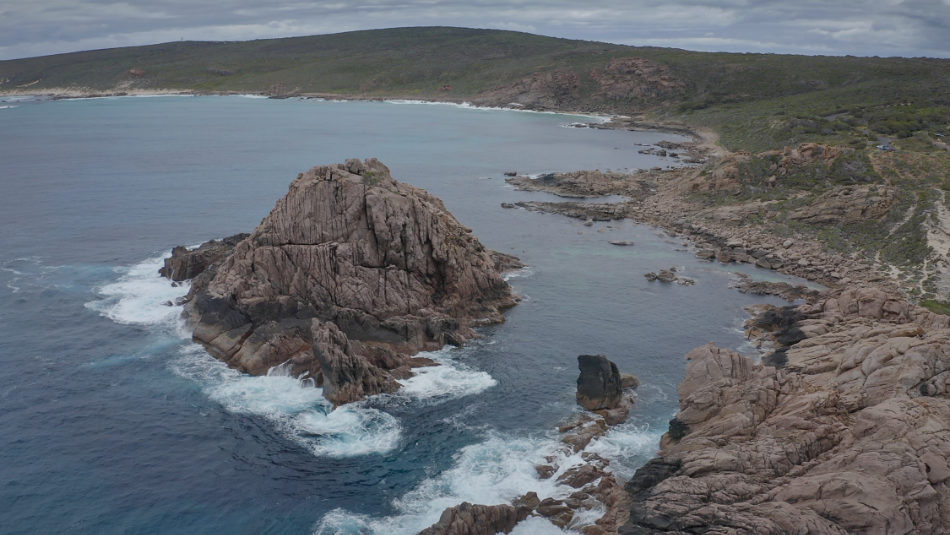
There are several ways you can discover great locations for landscape photography.
Following to social media accounts of photographers you admire is a great way to learn about spectacular locations that provide images that have impressed you.
Also, follow other photographers in your area, as they will shoot in locations close to where you live. Having a list of the photogenic local places will inspire you to get out and shoot more.
Check out tourism information from visitor centers and websites to see the locations and hidden gems they promote in a particular area.
Engaging in online forums with people that have visited or live in the area can help get local knowledge of a region you may not be familiar with.
While the suggestions above can help research potential locations, the most successful way to discover and confirm a great area to shoot in is to travel and explore places for yourself.
Physical walking around a location allows you to witness the environment and begin connecting with the landscape. It provides the best opportunity to observe and identify subjects and elements and evaluate a landscape’s potential for creating an impressive photo.
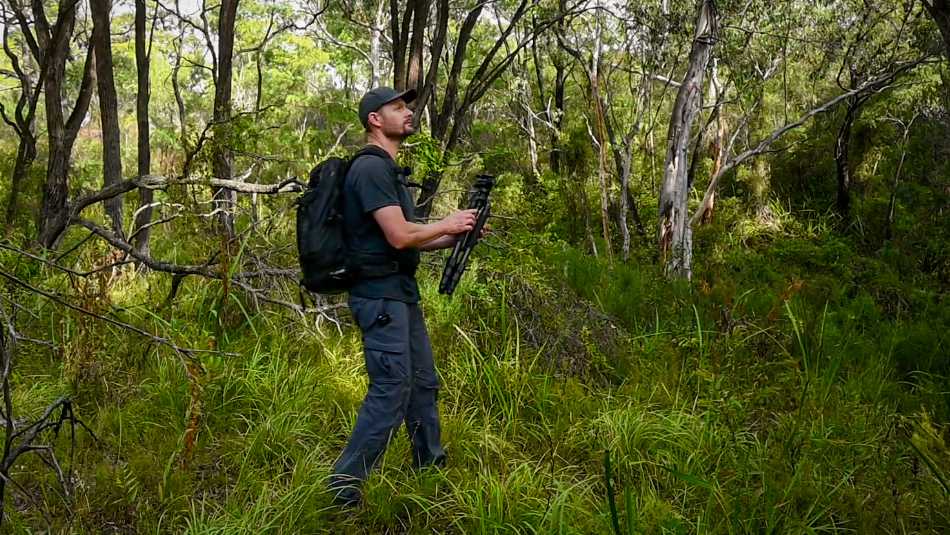
Having a location in mind is an excellent first step, but a little planning can make the trip a better experience, more rewarding, and result in you taking better landscape photos.
Consider things like when the best time of the day to visit is and where and when the sun rises and sets. This will help determine when you should arrive and how long you will likely be there.
You may get an idea of what type of shots you want to take, which will help you work out which lenses you need to pack.
Also, take into account access to the area, where you can park your car, how long you’ll need to walk, and what terrain you are likely to encounter.
This planning will give you a good idea about what gear to take, the clothes and shoes to wear.
Finally, remember to pack food and water.
More detailed planning is required for longer trips or if the location is remote, including safety gear and first aid kits. Plus, consider communication options if phone reception is unavailable.
It might seem obvious that you need a photogenic location to take beautiful landscape photos, but there’s more to it.
Finding the Photographic Potential in Locations
Even if you find a gorgeous location with lots of potential for landscape images, you need to discover the photographic scenes within that location.
To uncover those beautiful views and impressive subjects to shoot, you need to explore the area, observe the landscapes, and identify the elements, textures, colors and shapes that catch your eye and capture your attention.
This often takes time.
So get to a location early and take some time to allow yourself to explore.

This is one of the most rewarding parts of landscape photography as I engage with the natural environment.
You could think that the more impressive the location, the more likely you’ll be able to find appealing scenes to shoot, and while that can be true, it’s always the case.
While some locations are so stunning, you could almost point to the camera anywhere and take a fantastic photo.
Other incredible locations can be so awe-inspiring that they are overwhelming, and it takes some time to absorb what you can see and find the scene that would make an engaging picture.
The opposite can also be true.
Locations that may seem plain and lack instant photograph appeal can offer exceptional scenes to capture if you spend time and effort exploring the landscape and finding an area that can provide curiosity or appeal.
Tips for discovering great landscape locations:
- Follow other photographers in your area whose work you admire to see the locations they shoot
- Plan your trip, access options, and the terrain, and be prepared to maximize your comfort
- Arrive at a location early to give yourself time to explore the place
Create Compositions that Tell Engaging Stories
Whether a location is naturally stunning or requires some time and effort to discover those hidden gems, you will only walk away with an impactful landscape image if you can find a strong composition.
It’s helpful to think of images of the Landscape as stories.
The scene’s subjects and other elements can be considered the characters. Those objects and how they interact with one another make up the content of the story.
However, a critical component is how the story is told or your composition to present the scene.
To create an engaging story, you must find a composition that draws the viewer in and presents the landscape in a way that captivates the audience.
To create an engaging story, you must find a composition that draws the viewer in and presents the landscape in a way that captivates the audience.
In landscape photography, composition entails carefully considering which elements and objects to include or exclude within the frame and arranging them to achieve a visually pleasing and well-balanced image.
Composition is one of the most critical core principles of landscape photography.
You can only create a captivating landscape photo with a strong composition, regardless of whether the other principles are addressed.
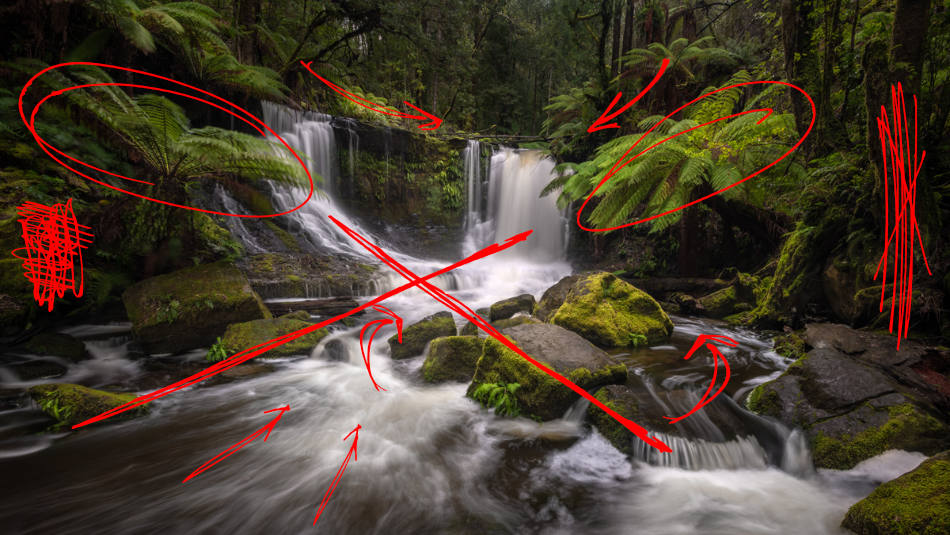
You have the most significant impact on your photo through your composition.
For this reason, the composition is where you can make serious improvements in your landscape photography.
There are four ways that the composition works in a landscape image to create an engaging photo.
- Defines what the story is about by the elements and main subject included in the frame.
- Creates a flow so the viewer is guided through the image
- Provides structure so the photo is pleasing to view
- Enhances the scene by adding emotion and feeling that helps transport the viewer
Knowing how composition works in a landscape photo makes it easier to understand and apply composition techniques to improve your pictures.
Tips for improving how your landscape compositions:
- Move around the location to change the angle and how the elements are arranged in your image.
- Understanding how the composition can improve your image
- Experiment with different composition techniques to learn how they affect the image.
Understand and Read the Light
While Light is one of many elements in a scene, how it interacts with the landscape makes it important enough to consider it a core principle.
Some form of light exists in every image we take.
The impact light has as it enhances other elements in a landscape is incredibly powerful.
The main types of light found in a landscape are:
- Direct Light – Tends to be strong and casts shadows
- Diffused Light – Scatters light from the clouds, so it’s softer
- Reflected Light – Light decreases in intensity as it bounces off objects in the scene
There are several ways light can be used to enhance and scene.
Light can highlight a subject, strengthen the texture on an object’s surface, illuminate other elements in a scene, or create an atmosphere or mood in a landscape.
Through experience and experimentation, you can improve your understanding of how light can work within a landscape to enhance elements in a scene.
Light can often have specific characteristics in a particular location.
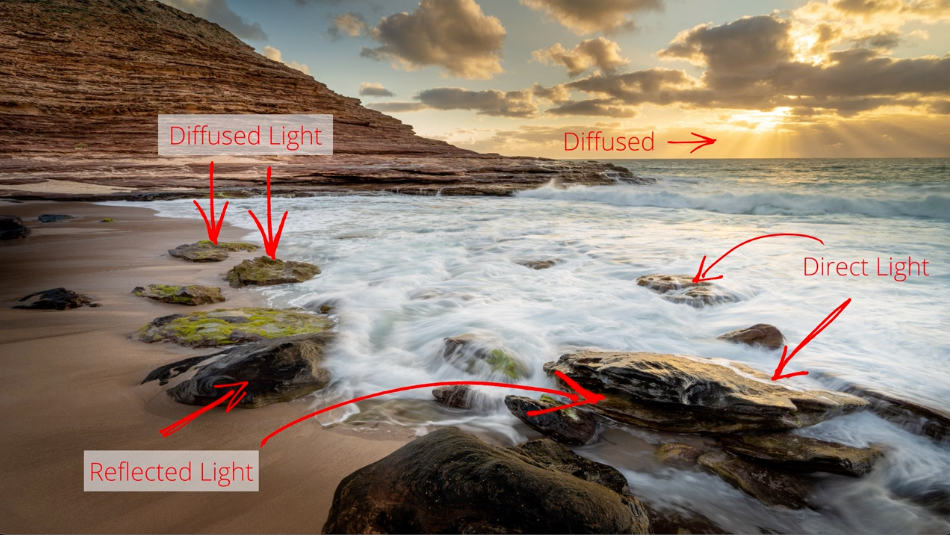
One advantage of returning to an area multiple times is you become familiar with the features in the landscape, and you build an awareness of how the light behaves and its impacts on the landscape.
Predicting the light and how it behaves under certain conditions is a helpful skill to develop as it allows you to anticipate the light as it changes more easily.
You can’t control the light, but you can use the light by considering how it interacts with other elements in the landscape and how you capture that interaction in your composition.
Taking into account the direction of the light as you frame a scene and the angle of the camera relative to the light’s source,
The only other level of control you have is to wait for the natural light to change. So anticipating how the light will change and having the patience to wait for the ideal light for the scene is critical.
One debate amongst landscape photographers is whether composition or light is more important in an image.
Regardless of what side you are on, everyone agrees that both principles are vital to have for any landscape picture.
I created this video to explain my position.
I argue that composition is more critical because you can create an image with almost any light, so long as you have a strong composition that tells the story in a compelling way.
Tips for improving how you use light in landscape images:
- Understand how light works within a landscape scene
- Observe the light to learn how it changes in a location
- Anticipate how the light will change so you are ready
Capture the shot Correctly
As you work out your composition, you begin to visualize the shot you want to take.
The next core principle to achieve that image is setting up the camera with the required settings to capture the shot correctly.
Knowing which settings to use to create the effect you want in a photo is necessary.
The aperture you select determines the Depth of Focus, the shutter speed can affect the amount of motion blur, and the ISO will gauge how clean the shot is.
At the same time, the aperture, shutter speed, and ISO also control the image’s exposure, so you must consider how these settings impact your photo in several ways.
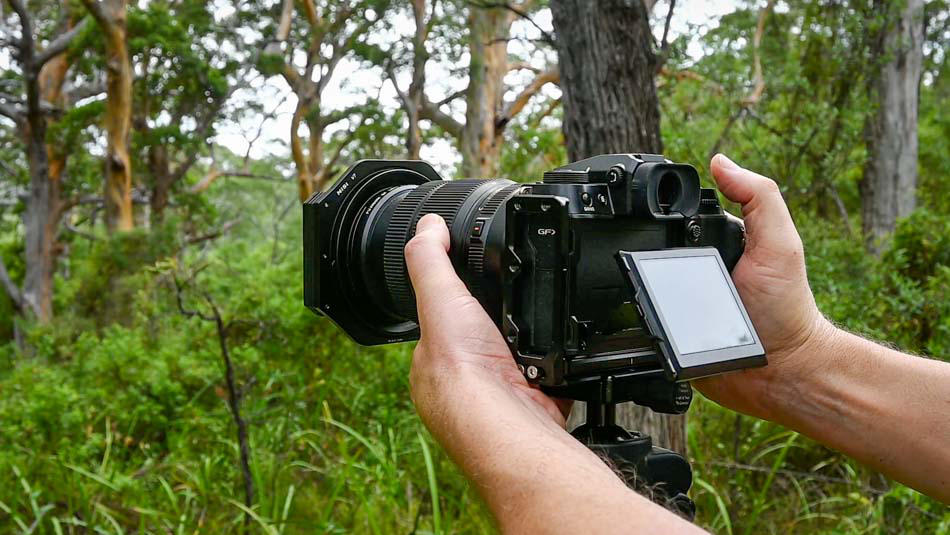
Other decisions include working out where to focus the camera, deciding if you need to focus bracket or exposure bracket the scene or to use setting a time delay.
Once you know which settings you want to use, you must be proficient enough with the camera you’re using to dial those settings effortlessly.
This is where many students I’ve taught in my photography workshops can come unstuck as they don’t know how to operate their camera so that they can make the necessary adjustments quickly to capture the shot before that moment of light has disappeared.
Beyond settings, that are other factors to think through.
For scenes with a wide dynamic range, you may use specific filters to even out the light or other filters to reduce the brightness across the picture.
Plus, considerations around stabilizing the camera, whether mounted to a tripod or handheld.
Tips for improving how you capture better landscape images:
- Develop an understanding of how the settings will affect the image
- Know our camera so you can quickly change settings when required
- Experiment with your setting to create different effects
Editing the Image to create the final photo
So you’ve captured your image and thought you were done…not quite!
Until now, all the work has been put into discovering, composing and capturing the RAW image – you are shooting RAW, right?
The RAW file will look dull and lack contrast. This is because it has all the detail and photographic information from the scene you captured, and now you are ready to bring out the scene’s beauty through the editing process.
Post-processing is a vital core principle as you take the RAW image you captured and enhance it using software to create the final photo you visualized when you were on location.
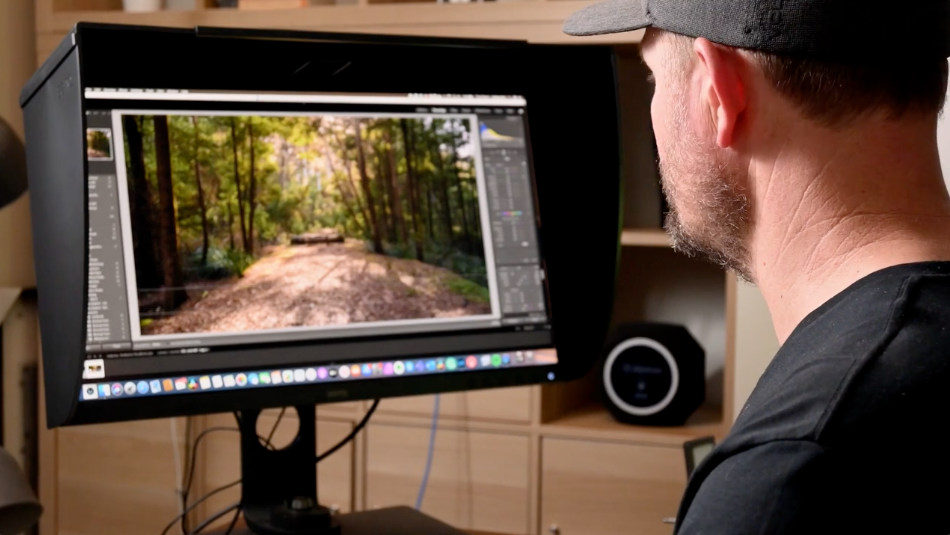
The editing process involves many factors mentioned in the other core principles.
In landscape photography, editing goes beyond replicating what you saw. It improves the image to enhance the mood and feeling within the landscape, building on your composition and amplifying the light within the scene.
When post-processing, you make global adjustments to the whole image with local adjustments that only impact parts of the photo you select.
Slight modifications can be made to the composition by cropping the image, and the flow of the image and how you guide the viewer’s eye through the scene can be strengthened through various editing techniques.
Subjects you want the audience to notice can be made more prominent, and distracting elements can be reduced to increase the image’s overall impact.
Tips for improving how you edit your landscape images:
- Become familiar with how your favorite editing software works
- Develop a workflow for your editing process
- Make global and local adjustments
- Think about enhancing what you achieved with the composition, light and capture
- Improve the image by building the mood and feeling in the photo.
QUICK RECAP
The 5 core principles are location, composition, light, capture and editing.
These 5 core principles define the areas where you can improve the image you create.
Location is both discovering incredible places and finding scenes within an area.
Composition deals with how the elements in the scene are arranged to help the viewer make sense of the landscape.
Light is an essential element that interacts with the rest of the landscape.
Capture involves setting up your camera and other photography gear to achieve the image you are visualizing.
Editing enhances the image to draw out the beauty to create the final photo.
